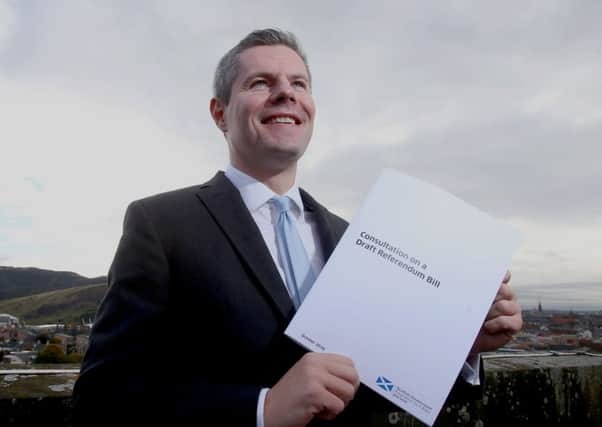Leader comment: Being fair cuts both ways for indyref2


The First Minster’s view is that the SNP manifesto for the 2015 elections specifically held out the prospect of a second independence referendum in the event that the UK voted to leave the EU and Scotland voted to stay in. The SNP was elected to govern on the basis of policies laid out in that manifesto and that then gives a clear mandate for a second referendum. Ms Sturgeon is absolutely entitled to hold that view, indeed it would be difficult to explain to the voters who backed her party if she chose to go back on it.
The counter-argument on democracy is that in 2014 Scotland voted to remain a part of the UK, and that in the EU referendum the UK voted to leave, and that Scotland needs to abide by the majority as in all democratic decisions. But the SNP are in power in Scotland and power has its privileges.
Advertisement
Hide AdAdvertisement
Hide AdIt is worth bearing in mind that the publication of the consultation document does not mean in itself that the second referendum will now take place. This is simply part of the complicated process of Brexit. In her foreword to the consultation document Ms Sturgeon commits her government to working with the UK government to negotiate a future relationship with Europe which works for “the overwhelming majority of the Scottish people” and the UK as a whole. She says they will put forward constructive plans.
It is only in the event that this cannot be achieved that the option of a second independence referendum will be held, it is said. What is not clear, of course, is how the views of the overwhelming majority of the Scottish population will be gauged once the details of the Brexit negotiations are known.
As things stand currently the Scottish Government’s narrative is that Scotland’s best interests will lie in the country playing as large a part as possible in the single market. That in itself remains a moot point.
However European leaders have said that there can be no access to the single market unless there are also some concessions given in allowing the free movement of people. The message from the UK government is that they will retain the ability to restrict access. It seems there is an impasse, but then it is not beyond the realms of possibility an acceptable compromise could be negotiated, even if currently that seems unlikely.
Another way would be for Scotland to have its own deal with the EU, in fact to that end Ms Sturgeon has asked Theresa May to grant Scotland powers over international trade deals and immigration controls. Even if all the European nations were happy to go along with this, it is hard to see Mrs May finding “soft independence” acceptable.
So a second independence referendum remains a distinct possibility, and that is why it is worth examining the consultation document that has been published, and taking the exercise of consultation seriously.
Most aspects are uncontentious: it is proposed that the same question is used as was used in 2014, and the vote be extended to the same people as last time, including 16 and 17 year-olds and citizens of EU countries who have made Scotland their home.
A subject that will perhaps engender more debate is the proposed ruling that no public money will be given to campaign groups and that this will include “material that provides information about the referendum”. This counts only during the official 16-week campaign period. For the last Scottish independence referendum there was an outcry when the Scottish Government published its White Paper before the official campaign period started. How the machinery of state is used in the run-up to any second vote will be worthy of careful discussion.
Advertisement
Hide AdAdvertisement
Hide AdAnd the other issue that will merit much debate is the proposal to go with a simple majority for victory again, with no minimum turnout requirement. Many believe for constitutional matters a greater threshold is needed.
Scotland’s major opposition parties have declared their resistance to a second independence referendum, and no doubt they will put heart and soul into that, but with ministers deciding on whether to submit a bill to parliament where at present the SNP and Scottish Greens form a small pro-independence majority, it is not quite clear what success they can hope for.
But the biggest concern in all of this is the timing. The First Minister says Scotland should be ready to hold a vote before the UK leaves the EU. The Brexit negotiations and how Scotland fits into those will form part of that, and that will only be known in perhaps two years.
But in order to make an intelligent choice, Scots will also need to know exactly what is being held out for an independent Scotland in terms of EU membership and financial contribution, and of course currency.
In order for any referendum to reach “the highest level of fairness” – the Scottish Government’s self-imposed standard – surely the First Minster must now pledge to lay before the Scottish people hard, factual answers on these matters and others before any second poll. Without that it would be impossible to determine where the best interests of Scotland lie.